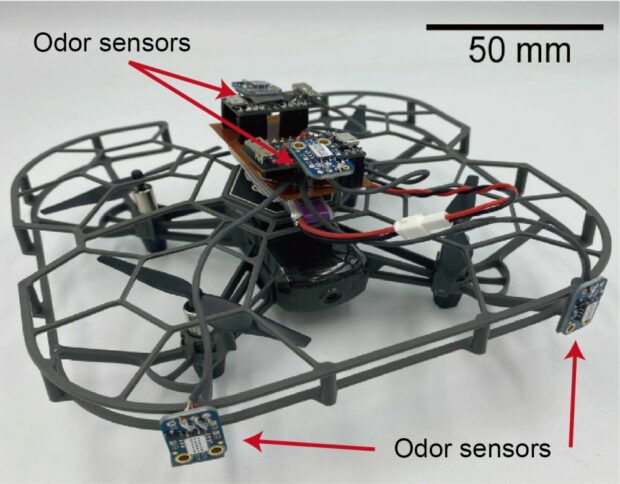Researchers from Osaka University, SoftBank and Tokyo Institute of Technology have created a new drone design allows it to act like a flying gas detector.
This drone, presented in a paper published in IEEE Transactions on Instrumentation and Measurement, are based on an airflow visualization technology known as particle image velocimetry.
“Research on 3D odor source localization using a drone is still in its developmental stage,” Shunsuke Shigaki, one of the researchers who carried out the study, told TechXplore. “In our previous studies, we mounted one or two odor sensors on a drone, which moved widely in height and crosswind directions to find the odor source. We found that this method is very inefficient, and given the short flight time of the drone, it was necessary to significantly improve the 3D odor tracking performance.”
“If robotic systems can monitor odors similar to animals, they can contribute to fields associated with gas emission,” the team wrote. “Such as toxic gas detection and location, rescue operations, explosive detection and location, air pollution source tracking and fire incidents.”
The palm-sized drone created by Shigaki and his colleagues is based on particle image velocimetry, an optical technique to measure the velocity field of an entire region in the air flow at once. The researchers specifically used this technique to identify the direction from which chemicals are arriving.
To monitor chemicals in the air in three-dimensions, the team integrated odor sensors on the upper and frontal surfaces of their drone. To accommodate this unique sensor arrangement, they developed a 3D surge-casting algorithms inspired by the biological mechanisms through which flying moths can track chemical plumes.
“The strength of our research group is that we are good at airflow visualization technology,” Shigaki said. “Focusing on the changes in airflow produced by a drone, we noticed that the drone intakes odor differently depending on the height of the odor source. Therefore, we designed an odor sensor arrangement and an algorithm that can continuously track an odor regardless of what direction it comes from.”
The researchers evaluated their proposed chemical plume tracking drone in a series of airflow visualization and localization experiments. Remarkably, they found that the algorithm they developed outperformed conventional algorithms for chemical plume tracking, effectively tracking odors even in scenarios where the direction of the wind keeps changing.
In the future, the palm-sized drone and chemical plume tracking algorithm developed by Shigaki and his colleagues could pave the way for the creation of better performing robotic systems for detecting odors and identifying their sources. In their next studies, the researchers also plan to improve their design to ensure that the chemical plume tracking system also performs well in uncertain, cluttered and unmapped environments.
“Odor diffusion is very complex, but our proposed combination of sensor arrangement and algorithm enables highly efficient odor source localization,” Shigaki explained. “We hope that our proposal will be the fundamental technique for drone olfaction. We now would like to contribute to safety and security by developing a system that can search for dangerous chemicals or explosives quickly by using multiple drones to search for multiple odor sources.”
Source: TechXplore

